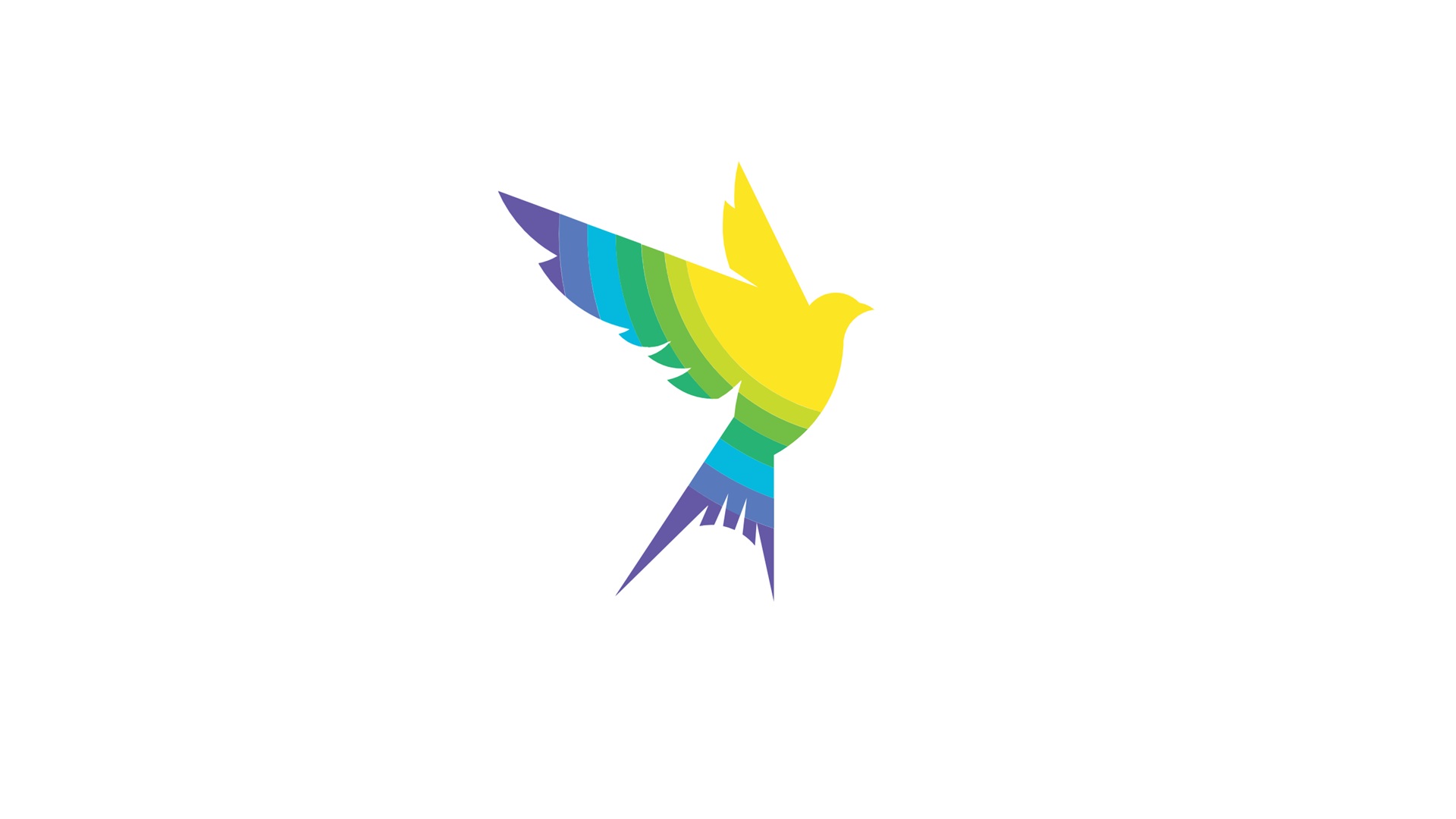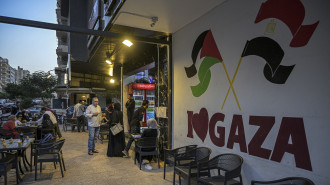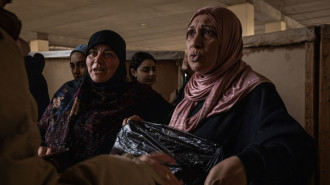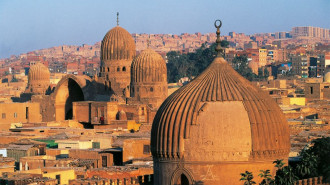
An Easter miracle: Antakya's Orthodox Christian community returns to life after earthquake

Patriarch John X Yazigi hitches up his black cassock and clambers over the rubble, helped along by the arms of the faithful.
It is a beautiful spring morning in southern Turkey and the congregation of the Arabic-speaking Orthodox community of Antakya is gathered in the courtyard for the Easter Mass.
But around them their church lies in ruins, destroyed by the earthquake that tore through the region two months ago, claiming more than 50,000 lives and sending two million people into exile. Many in the small crowd have lost their homes; all of them have lost loved ones.
"The Antiochene Orthodox have an ancient claim to the city which begins 2,000 years ago when the Apostles Peter and Paul founded the first Christian community here"
Within the courtyard, a square has been cleared of debris and plastic garden chairs are set out in place of pews.
At one end, a makeshift altar is surrounded by five icons propped up on easels. Beyond them, the large white wooden cross that once crowned the bell tower has been regathered and planted amongst the piles of broken masonry.
The congregation is smaller than usual, I am told, as the young help the elderly to their seats. Despite the hazardous terrain and the all-pervasive dust, everyone has put on their Sunday best.
Easter is a time of great joy for the Christian community, but at the mass, the atmosphere is heavy with grief. As a priest chants the liturgy, and the Patriarch blesses the bread and the wine, some look down, their eyes full of tears, whilst others stare blankly ahead, as if shocked by such a familiar ritual in a world so utterly changed.
“I was very sad during the ceremony,” says Father Dimitri, one of the local priests, “but we thanked our Lord for the peace and blessings of our community, our city, our country, the whole world. We didn't have many in the congregation,” he added, “but we felt everyone within us.”
Nowadays, the Antiochene Orthodox community of Turkey numbers perhaps only 10,000 people. It is one of a number of minority communities — along with Armenians, Alawites, Catholics, Syriac Orthodox, Jews and Arabic-speaking Sunnis — that make this southern part of the country so unusually diverse.
But the earthquake of February 6 that levelled the city has left its surviving population scattered across the region.
“As you can see, it has destroyed 80% of the buildings, destroyed all the churches, all the mosques, and the synagogue,” says Abud Abdo, a local resident, as we walk through the streets near the church. “I hope it will recover soon, but it needs some time for life to start back in this city.”
Without homes, livelihoods or places of worship to return to, many may decide that moving on is easier than moving back. For the minority communities, whose identity is tied to a deep attachment to the land, rebuilding after the earthquake has become a question of survival.
The Antiochene Orthodox have an ancient claim to the city which begins 2,000 years ago when the Apostles Peter and Paul founded the first Christian community here.
It was in Antakya, according to Saint Luke, that the disciples of Christ first called themselves Christians. Following the Islamic conquests of the 8th century, Arabic gradually began to replace Greek, Syriac and Aramaic as the vernacular language across the region, eventually also becoming the main language of the church liturgy.
"Everybody has lost their sparkle in life... they have lost their past and they have no hope for the future. As you could read from their eyes, they are all sad. It was a very dramatic and historical mass. I don’t know if there will be any other mass in this church for a very long time"
But this unique history also means the Antiochene Orthodox community has a particularly complex political identity within the modern Turkish state. Its members are at once Turkish nationals, Arabic speakers, and part of the Greek Orthodox church.
In a state with a deeply nationalist political culture and a lack of legal protection for minorities, maintaining the community’s identity is a daily struggle. There are no minority schools teaching the history or language of the community, and with every generation, Arabic is spoken less and less.
“The state discourse considers only three types of non-Muslim minorities in Turkey: Greek, Jewish, and Armenian. The rest are ignored or not much known,” explains Anna Maria Beylunioğlu, co-founder of Nehna, an online platform promoting awareness of Antiochene Orthodox identity. “When people hear my name, they often assume I am foreign,” she adds. “They ask where I am from, or tell me I speak really good Turkish.”
Nehna, which means ‘us’ in the local Arabic dialect, aims to inform a wider audience about the history and culture of the community without shying away from the complexity of its identity.
The platform arose from disagreements amongst friends on how to define themselves. Whilst they agreed on strong identity markers such as language, ritual, food, and music, they differed on where to put the emphasis.
For the more religious, ‘Greek Orthodox’ was most appropriate. Those who were privileged in linguistic and cultural aspects of their identity preferred ‘Arab Christian’. For Anna Maria, an academic in political science who also trained as a chef, it was through her training in cooking that she really started to reflect on her Antakyan heritage.
The earthquake has added new urgency to the politics of identity and protection of minorities in southern Turkey. The Government’s slow response has cost lives, and some within the community see a direct parallel between the lack of protection for minorities and the lacklustre rescue effort in the crucial days after the earthquake.
They are now concerned that the Government’s sweeping powers under the state of emergency will allow it to rebuild Antakya in its own monolithic model, leaving no place for the historic character of the city. One local, who preferred not to be named, feared it was, “an opportunity [for the government] to collapse our memories, our multiculturalism.”
In the face of such pressure, platforms like Nehna have started to take on a new role more akin to a civil society organisation. During the hours after the earthquake, as the scale of the disaster unfolded, Nehna’s social media accounts became a way of collating and disseminating information, putting people in touch and helping organise a spontaneous local response where the state was lacking.
|
Others are making similar efforts to advocate for local demands in response to the Government’s reconstruction plans. Iskender Azaroğlu and Zeynup Rustemoğlu are childhood friends from Antakya, who are now working together to set up a foundation to protect the cultural heritage of the city.
Iskender is also part of the Antiochene Orthodox community, whereas Zeynup comes from the Sunni community. They both speak of their pride in being from Antakya precisely because its history of coexistence is now so rare in Turkey.
When I ask Father Dimitri about the importance of returning to the church for the mass, he explains it in religious terms, and the need to be in a sacred space for the ceremony of the Eucharist. But it is hard to ignore the political symbolism of return in an atmosphere where some in the community fear dispossession and erasure.
Emre Can Dağlioğlu, another founder of Nehna, recently wrote that, with Easter approaching, “every ritual in Antakya is now an act of resistance”.
A visit from the Patriarch, who normally resides in Damascus, is very rare. His final act on Easter morning was to appoint Father Pavlus as his patriarchal deputy in Antakya. It is a title that has been out of use for many years, and a position — given the scale of loss — that has rarely had such a daunting task.
As I chat with Iskender and Zeynup about the past and their memories of childhood in Antakya, the conversation inevitably turns to those they have lost.
Iskender pulls out his phone and starts flicking through a file of old photos of him, Zeynup and Kemal Tolu — a school friend who died two months ago, trapped, like so many others, beneath the walls of his own home.
For a few moments, Zeynep and Iskender interrupt each other in their haste to recount each captured memory until Iskender’s hand suddenly drops and he slouches back into his chair, “What does it mean after this?” he asks himself quietly, “What is it all for?”
This grief is clear in everyone I speak to.
Once the ceremony has finished, and we pick our way back through the wreckage of the church to the street below, I ask Abud about the mood of the congregation. “Everybody has lost their sparkle in life,” he says, “they have lost their past and they have no hope for the future.
As you could read from their eyes, they are all sad. It was a very dramatic and historical mass. I don’t know if there will be any other mass in this church for a very long time.”
Surrounded by the ruins, it is hard to disagree. But nestled with the grief is a determination, shown by the church and by civil society, to resist any future for the city that isn’t also home to its historic minorities.
Andrew James is an independent writer based in Istanbul.
Follow him on Twitter: @andrew__james

![Easter Mass is held in Samanadağ, Hatay, a region shattered by the earthquake [Getty Images]](/sites/default/files/styles/medium_16_9/public/2023-04/GettyImages-1482679325.jpg?h=199d8c1f&itok=_qnzE1Pg)
![Palestinians mourned the victims of an Israeli strike on Deir al-Balah [Getty]](/sites/default/files/styles/image_684x385/public/2024-11/GettyImages-2182362043.jpg?h=199d8c1f&itok=xSHZFbmc)


![The law could be enforced against teachers without prior notice [Getty]](/sites/default/files/styles/image_684x385/public/2178740715.jpeg?h=a5f2f23a&itok=hnqrCS4x)
 Follow the Middle East's top stories in English at The New Arab on Google News
Follow the Middle East's top stories in English at The New Arab on Google News


